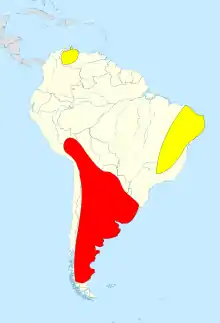Xenorhinotherium
Xenorhinotherium is an extinct genus of macraucheniids, closely related to Macrauchenia of Patagonia. The type species is X. bahiense.[1]
| Xenorhinotherium | |
|---|---|
| Scientific classification | |
| Kingdom: | |
| Phylum: | |
| Class: | |
| Order: | |
| Family: | |
| Genus: | Xenorhinotherium Cartelle & Lessa 1988 |
| Species: | X. bahiense (type) |
 | |
| Map showing the distribution of Macrauchenia in red, and Xenorhinotherium in yellow, inferred from fossil finds | |
Taxonomy
Some authors place X. bahiense in the genus Macrauchenia (as M. bahiensis, while still others consider it the same species as M. patachonica. The genus name Xenorhinotherium means "Strange-Nosed Beast" and bahiense refers to the Brazilian state of Bahia, where its fossils are found.[2]
Characteristics
X. bahiense was a megafaunal herbivore that probably looked very much like a larger version of Macrauchenia, averaging around 5 meters in length, and was approximately 3 meters in height. In life, X. bahiense that is, vaguely like a very tall, humpless camel with and three toes on each foot, with either a small, saiga-like proboscis,[3] or a moose-like nose.[4] However, 12,600 to 11,800 year old pictographs from the Serranía de La Lindosa rock formation of Guaviare, Colombia, however showed what might possibly be Xenorhinotherium with a trunk.[5][6]
Distribution
Fossils of Xenorhinotherium, dating to the Late Pleistocene, have been found in the states of Bahia, the Jandaíra Formation of Rio Grande do Norte,[1] and Minas Gerais in modern Brazil,[7] and also in Venezuela, in the localities of Muaco, Taima-Taima and Cuenca del Lago.[8][9]
References
- Xenorhinotherium at Fossilworks.org
- Cartelle, C.; Lessa, G. (1988). "Descrição de um novo gênero e espécie de Macrauchenidae (Mammalia, Litopterna) do Pleistoceno do Brasil" [Description of a new genus and species of Macrauchenidae (Mammalia, Litopterna) from the Pleistocene of Brazil]. Paulacoutiana (in Portuguese). 3: 3–26.
- The illustrated encyclopedia of dinosaurs and prehistoric animals. Palmer, Douglas., Cox, C. Barry (Christopher Barry), 1931-. London: Marshall Pub. 1999. ISBN 1-84028-152-9. OCLC 44131898.CS1 maint: others (link)
- Moyano, Silvana Rocio; Giannini, Norberto Pedro (November 2018). "Cranial characters associated with the proboscis postnatal-development in Tapirus (Perissodactyla: Tapiridae) and comparisons with other extant and fossil hoofed mammals". Zoologischer Anzeiger. 277: 143–147. doi:10.1016/j.jcz.2018.08.005.
- Morcote-Ríos, Gaspar; Aceituno, Francisco Javier; Iriarte, José; Robinson, Mark; Chaparro-Cárdenas, Jeison L. (29 April 2020). "Colonisation and early peopling of the Colombian Amazon during the Late Pleistocene and the Early Holocene: New evidence from La Serranía La Lindosa". Quaternary International. doi:10.1016/j.quaint.2020.04.026.
- "12,000-Year-Old Rock Drawings of Ice Age Megafauna Discovered in Colombian Amazon | Archaeology | Sci-News.com". Breaking Science News | Sci-News.com. Retrieved 2020-12-04.
- Scherer, Carolina; Pitana, Vanessa; Ribeiro, Ana Maria (28 December 2009). "Proterotheriidae and Macraucheniidae (Litopterna, Mammalia) from the Pleistocene of Rio Grande do Sul State, Brazil". Revista Brasileira de Paleontologia. 12 (3): 231–246. doi:10.4072/RBP.2009.3.06.
- Socorro 2006, p. .
- Morón 2015, p. 110.
Bibliography
- Morón, Camilo (January 2015). "Panorama geológico, paleontológico, arqueológico, histórico y mitológico del estado Falcón" [Geological panorama, paleontology, archeology, history and mythology in the State of Falcon, Venezuela]. Boletín Antropológico (in Spanish). 89 (1).CS1 maint: ref=harv (link)
- Socorro, Orangel Antonio Aguilera (2006). Tesoros paleontológicos de Venezuela: el cuaternario del Estado Falcón [Paleontological treasures of Venezuela: the quaternary of the Falcón State] (in Spanish). Ministerio de la Cultura. ISBN 978-980-12-1379-6.CS1 maint: ref=harv (link)
Further reading
- Nascimento, Karoliny de Oliveira (27 February 2019). Paleoecologia alimentar de macrauchenia patachonica e xenorhinotherium bahiense (macraucheniidae: litopterna: mammalia) e o reconhecimento de seus nichos ecológicos [Food paleoecology of macrauchenia patachonica and xenorhinotherium bahiense (macraucheniidae: litopterna: mammalia) and the recognition of their ecological niches] (Thesis) (in Portuguese).
- McGrath, Andrew J.; Anaya, Federico; Croft, Darin A. (4 May 2018). "Two new macraucheniids (Mammalia: Litopterna) from the late middle Miocene (Laventan South American Land Mammal Age) of Quebrada Honda, Bolivia". Journal of Vertebrate Paleontology. 38 (3): e1461632. doi:10.1080/02724634.2018.1461632. S2CID 89881990.
- de Oliveira, Karoliny; Araújo, Thaísa; Rotti, Alline; Mothé, Dimila; Rivals, Florent; Avilla, Leonardo S. (March 2020). "Fantastic beasts and what they ate: Revealing feeding habits and ecological niche of late Quaternary Macraucheniidae from South America". Quaternary Science Reviews. 231: 106178. Bibcode:2020QSRv..23106178D. doi:10.1016/j.quascirev.2020.106178. S2CID 213795563.
